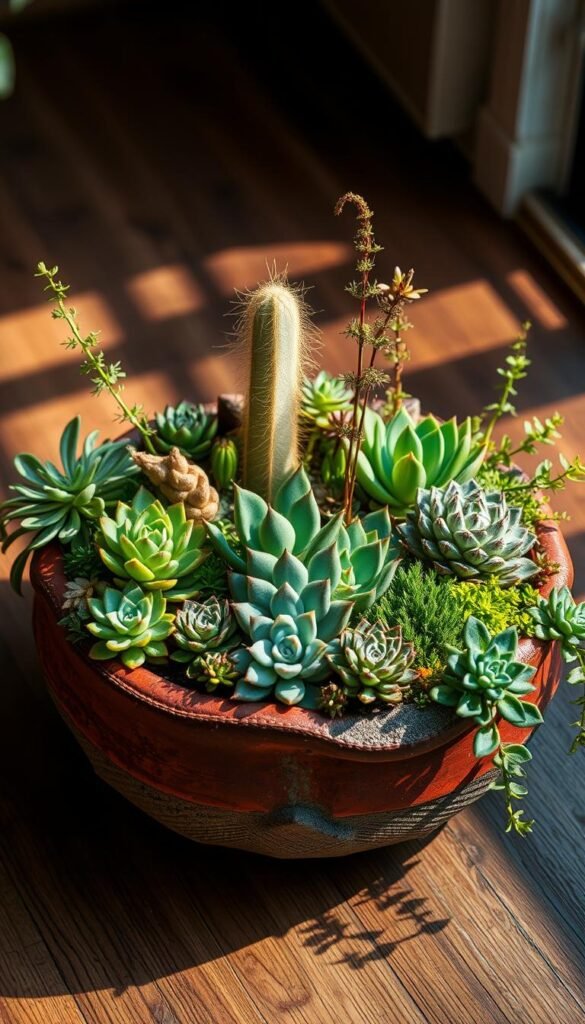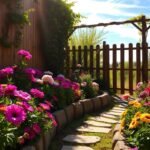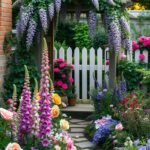Transform shallow containers into vibrant living displays that brighten any room. These compact ecosystems combine multiple plants in artistic arrangements, offering year-round natural beauty without needing outdoor space. Perfect for apartments or small homes, they let you cultivate greenery wherever sunlight filters through your windows.
You’ll discover how to craft temporary displays for special events or build lasting installations that evolve over time. We’ll explore diverse themes like arid desertscapes and lush tropical setups, helping you match designs to your existing furnishings. No prior gardening experience needed – our methods work for first-timers and plant enthusiasts alike.
This guide simplifies material selection, from choosing compatible succulents to picking containers that complement your style. Learn proper soil preparation and watering techniques that prevent common issues like root rot. We’ll even show you how to troubleshoot lighting challenges in different rooms.
Whether creating a personalized centerpiece or a thoughtful gift, these projects adapt to any season. You’ll gain confidence in maintaining your miniature landscape while developing skills that apply to larger outdoor gardens. Let’s begin your journey into this rewarding form of botanical artistry.
Understanding the Dish Garden Concept
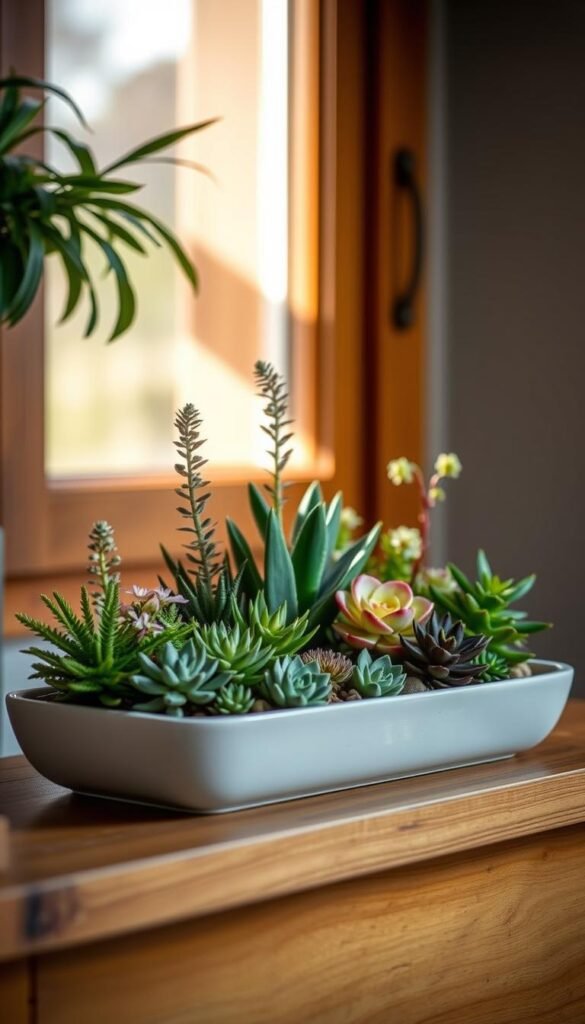
Crafting a miniature world in a shallow container brings nature’s charm to tabletops and shelves. These living arrangements merge design with horticulture, letting you arrange multiple species in one cohesive display. Unlike traditional potted greenery, they mimic natural environments through thoughtful layering and plant pairing.
What Is This Style of Planting?
Think of it as a 3D painting using succulents, mosses, and decorative rocks. You’ll work with containers no deeper than 4 inches – ceramic bowls or recycled trays work perfectly. Two main approaches exist: quick seasonal setups using short-lived blooms, or enduring ecosystems with slow-growing varieties.
Essential Components for Success
Every thriving miniature landscape needs three layers. Start with pebbles at the base for drainage, then add activated charcoal to keep water fresh. Finish with fast-draining soil suited to your chosen plants. Visual balance matters – mix trailing vines with upright specimens and textured ground covers.
You’ll love how these compact creations adapt to any space. Brighten a dim corner with shade-tolerant ferns or build a sunny succulent showcase. The best part? They teach core gardening skills like watering control and light management on a small, manageable scale.
Planning Your Dish Garden Project
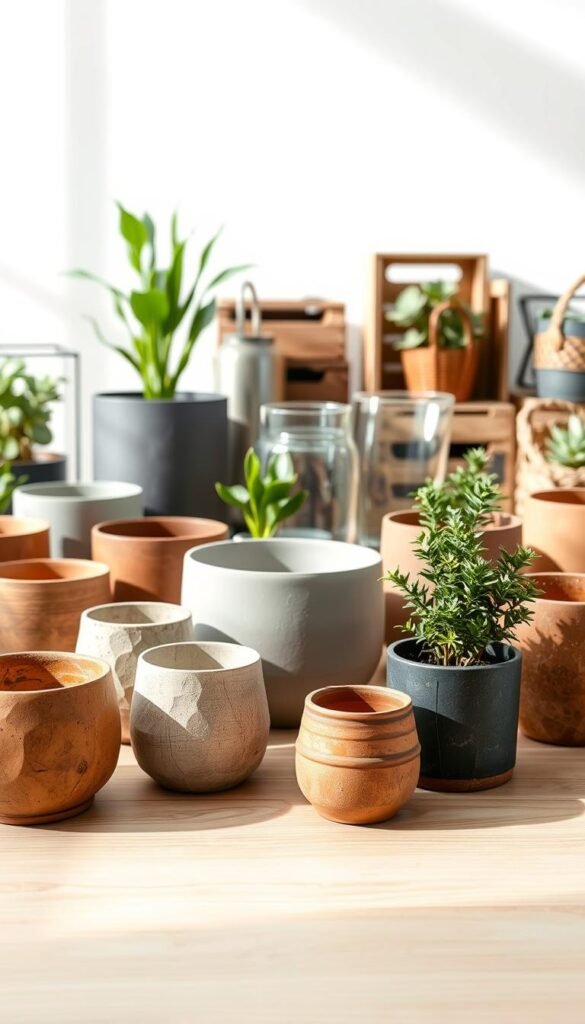
Successful living arrangements begin with smart preparation. Measure your display area first – a windowsill needs different dimensions than a coffee table centerpiece. Consider light patterns throughout the day, as this affects both your container choice and plant selection.
Choosing the Ideal Vessel
Vessels shape your project’s personality. Terra cotta pots offer breathability for moisture-sensitive varieties, while glass bowls showcase decorative soil layers. Ensure your chosen piece has drainage holes or space for pebbles at the base. Depth matters most – aim for 2-3 inches to accommodate roots without excess soil moisture.
Selecting Harmonious Varieties
Pair sun-loving succulents with other drought-tolerant species for easy care. Combine trailing ivy with upright snake plants for dynamic contrast. Remember: “Grouping plants with matching thirst levels prevents overwatering disasters,” advises urban gardener Lila Chen. Always check growth rates – slow-growing jade plants outlast faster species in long-term displays.
Balance visual weight by placing taller specimens toward the back of rectangular containers. For round vessels, create focal points with colorful bromeliads. Leave breathing room between leaves to accommodate growth over weeks and months.
Gathering Materials and Supplies
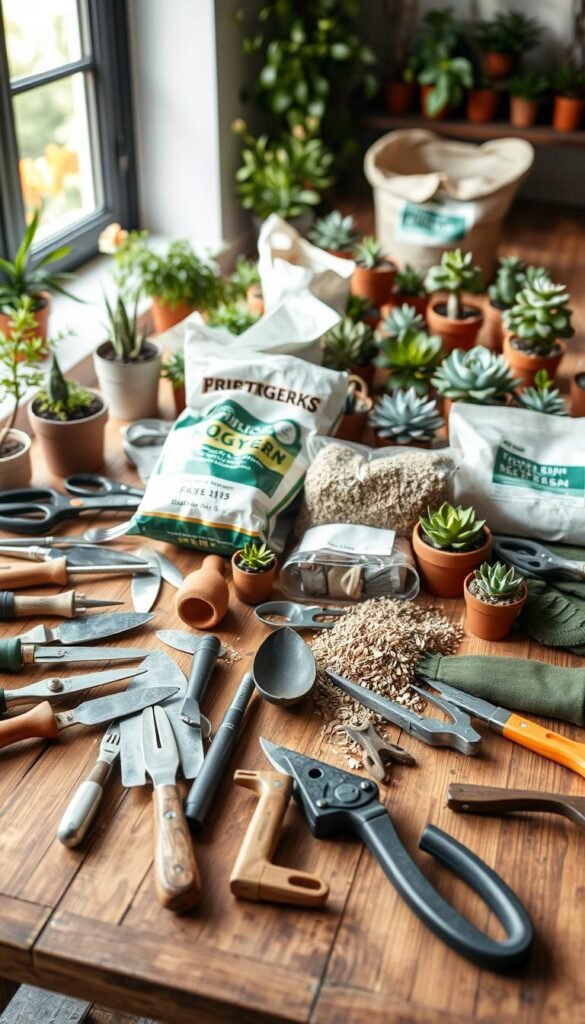
Laying the foundation for your miniature ecosystem starts with smart material selection. Quality supplies ensure your plants thrive while creating visual harmony. Let’s explore what you’ll need to bring your vision to life.
Essential Tools and Soil Mixtures
Begin with a balanced potting soil blend – mix equal parts standard soil and cactus mix for optimal drainage. Add horticultural charcoal to prevent odors and improve water flow. “Preparing your soil first saves time during assembly,” notes container gardening expert Marisa Thompson.
| Material Type | Purpose | Examples |
|---|---|---|
| Soil Amendments | Enhance drainage & nutrients | Perlite, worm compost |
| Tools | Precision planting | Mini trowel, angled spout can |
| Drainage Aids | Prevent root rot | Lava rocks, clay pebbles |
Adornments and Topdressing Options
Transform functional items into decorative features. Polished river stones double as moisture barriers, while preserved moss adds lush texture. Consider these finishing touches:
- Crushed glass in coordinating colors
- Driftwood pieces for natural contrast
- Metallic accents for modern flair
Organize all components before starting. This preparation lets you focus on creative arrangements rather than searching for missing supplies. With the right potting soil base and thoughtful adornments, your living artwork will flourish.
Preparing Your Dish Garden Setup
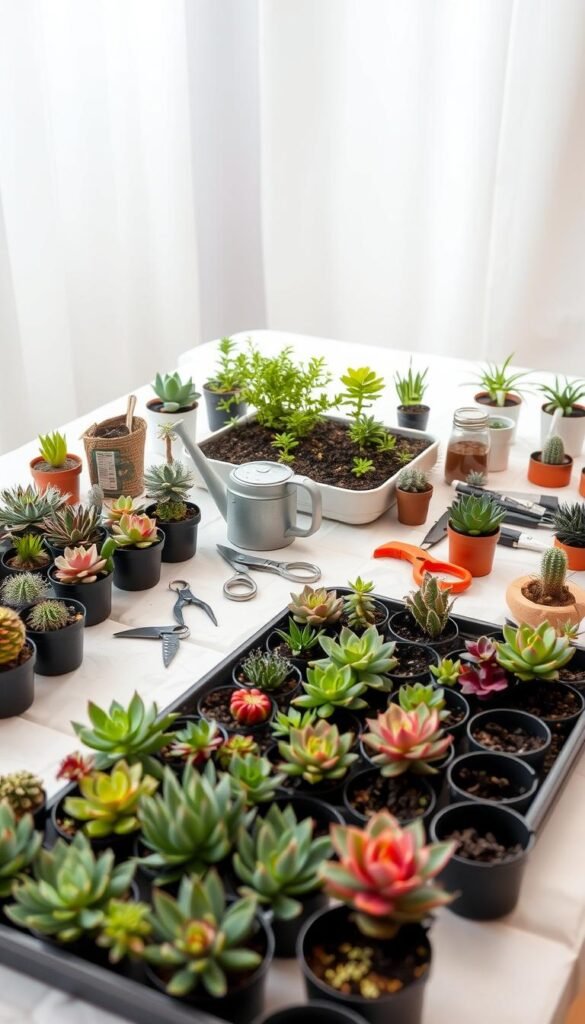
Smart groundwork transforms your vision into reality. Clear a flat workspace with room to spread materials – a kitchen counter or craft table works perfectly. Good lighting helps spot soil clumps and ensures precise plant placement.
Pre-Planting Tips for Success
Start by hydrating plants 48 hours before transplanting. This reduces shock and helps roots adjust faster. Clean your container thoroughly using mild soap – leftover residues can harm delicate root systems.
Create a drainage foundation with pea gravel, then add a charcoal layer to filter water. For containers without holes, this step becomes critical. “Proper layering prevents 80% of moisture issues,” notes urban horticulturist Tara Simmons.
Mix your soil blend until it crumbles like moist cake – aim for equal parts potting mix and perlite. Test consistency by squeezing a handful; it should hold shape briefly before breaking apart.
Arrange plants while still in their nursery pots to visualize spacing. Leave breathing room between species with different growth rates. If working in tight spaces, consider container gardening hacks to maximize your planting area efficiently.
Finally, position your setup where it’ll receive appropriate light daily. Rotate weekly for even sun exposure. With these preparations, you’re ready to build a thriving miniature ecosystem.
Dish Garden Ideas DIY: Simple Step-by-Step for Stunning Home Decor
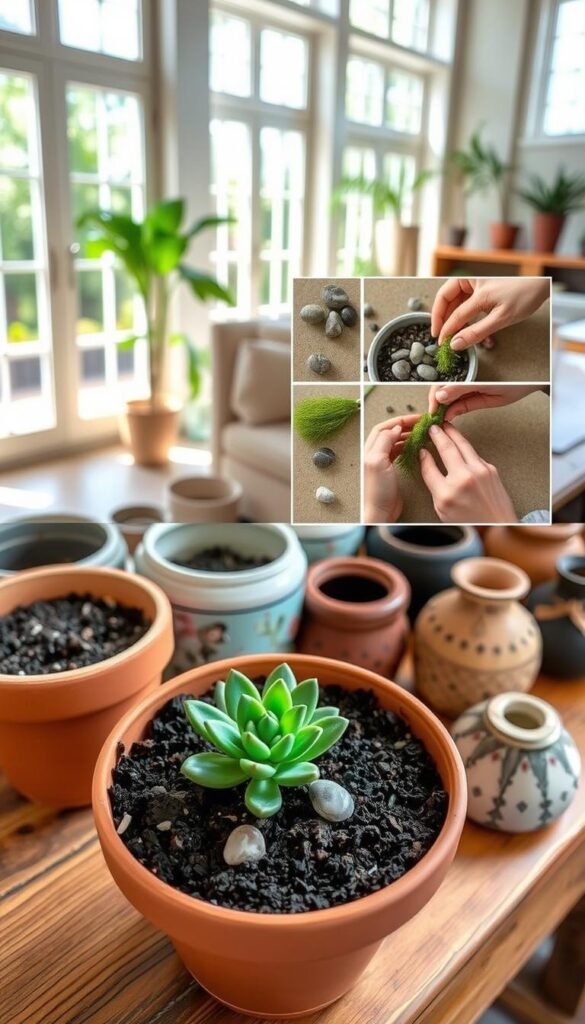
Turn everyday materials into living art through strategic layering techniques. Begin by filling one-third of your vessel with drainage stones, creating space for healthy root development. Add a thin charcoal layer to maintain freshness before pouring your custom soil blend – this foundation prevents waterlogging while nourishing plants.
Position greenery using the “high-low” method: place taller specimens toward the back and cascading varieties near edges. Leave ½ inch between stems for airflow. “The magic happens when creative freedom meets plant needs,” says designer Marco Bertoli. “Mix textures and heights, but always prioritize species compatibility.”
| Approach | Planting Method | Maintenance Level | Lifespan |
|---|---|---|---|
| Temporary Display | Potted plants nestled in moss | Low | 2-4 months |
| Permanent Installation | Rooted in custom soil mix | Moderate | 1-3 years |
Seal your design with decorative toppings that serve practical purposes. Colored sand creates desert vibes while retaining moisture, and crushed shells add coastal charm with natural pH benefits. Rotate your creation weekly to ensure even light exposure, and mist leaves instead of soaking soil for delicate varieties.
This method transforms basic components into eye-catching natural decor. You’ll develop skills in spatial planning and plant care that apply to larger projects. The best part? Each piece evolves as plants grow, offering new visual interest every season.
Step-by-Step Guide to Planting Your Dish Garden
Bring your miniature landscape to life with precise planting methods that ensure healthy growth. Start by selecting 2-4″ specimens for small vessels and mixing sizes in larger containers. This approach creates visual interest while preventing overcrowding.
Planting Techniques and Arrangements
Gently squeeze nursery pots to loosen roots before lifting plants out. Create holes in your soil mix slightly wider than each root ball. Position taller varieties toward the center or back, depending on viewing angles. Leave 1″ between stems for air circulation and future growth.
For lasting displays, use this layering strategy:
- Anchor with upright plants like haworthia
- Surround with trailing sedum varieties
- Fill gaps with colorful echeveria rosettes
Urban gardener Rachel Kim advises: “Tease apart tightly wound roots to encourage outward growth. This simple step helps plants adapt faster to their new environment.”
Watering and Drainage Considerations
Target water directly at root zones using a narrow-spout can. In warm climates, hydrate every 14 days—reduce to monthly in cooler months. Check drainage by feeling soil 1″ below surface; water only when completely dry.
Follow these container gardening fundamentals for success:
| Container Size | Water Amount | Frequency |
|---|---|---|
| Small (6″ diameter) | ¼ cup | As needed |
| Large (12″ diameter) | ½ cup | Seasonally adjusted |
Remember: Overwatering causes more issues than underwatering in these compact setups. Adjust your routine based on leaf firmness and soil texture changes.
Design and Style Inspirations
Unlock your space’s potential by blending living greenery with artistic expression through themed arrangements. Discover how different aesthetics can transform ordinary containers into conversation-starting displays that reflect your personality.
Exploring Desert, Fairy, and Tropical Themes
Southwestern desert designs thrive with prickly pear and agave nestled in rust-colored sand. Add terracotta pottery shards for authentic charm. Fairy garden creations invite wonder with tiny cottages and mushroom-shaped accents peeking between Irish moss.
Tropical paradises burst with croton plants’ fiery leaves and miniature bromeliads. Nestle smooth river stones among philodendron vines to mimic jungle streams. “Always match adornments to plant needs,” advises designer Elena Torres. “A pebble path in arid setups doubles as a moisture barrier.”
| Theme | Key Elements | Ideal Plants | Signature Accessories |
|---|---|---|---|
| Desert | Sand layers, warm tones | Barrel cactus, aloe | Driftwood, sun-bleached bones |
| Fairy | Whimsical textures | Baby tears, fittonia | Miniature lanterns, tiny benches |
| Tropical | Humidity-loving varieties | Fern varieties, peperomia | Seashells, bamboo stakes |
Creative Ideas for Unique Adornments
Coordinate container colors with blooming kalanchoe flowers for bold impact. Modern minimalist designs shine with geometric cement planters housing single sculptural succulents. For seasonal flair, swap autumn maple leaves for winter pinecones while keeping plants intact.
Add artistic touches with hand-painted rocks or metallic air plants. Remember: every decorative element should serve dual purposes. Glass marbles boost drainage while catching light, and moss pads help retain moisture between waterings.
Utilizing Household Items to Enhance Your Dish Garden
Unearth hidden potential in forgotten objects by transforming them into charming plant displays. Everyday items from your kitchen or attic become eco-friendly vessels when prepped correctly. This approach lets you craft living decor that reflects your personality while reducing waste.
Breathing New Life Into Old Containers
Search for durable pieces with interesting shapes at thrift stores or garage sales. Vintage teacups make adorable succulent holders, while wire baskets become rustic hanging displays. Wooden crates need plastic lining to prevent rot, and metal tins require drainage holes drilled in their bases.
- Colanders become airy homes for herbs with their built-in drainage
- Glass jars showcase colorful pebble layers beneath small ferns
- Ceramic baking dishes transform into desert landscapes with cacti
Designer Amy Vanderbilt suggests: “Let the container’s history guide your plant choices. An old tool box begs for rugged sedums, while a crystal bowl deserves delicate air plants.”
| Material | Preparation Needed | Best Plant Matches |
|---|---|---|
| Glass | Add drainage layer | Tillandsia, moss |
| Metal | Prevent rust with sealant | Succulents, herbs |
| Wood | Line with plastic | Ferns, ivy |
| Ceramic | Drill holes | Cacti, flowering annuals |
Add whimsical touches with bottle cap markers or button accents. These small details create visual interest without overwhelming your plants. Remember: functional decor works best when it supports healthy growth while showcasing your creative flair.
Caring for and Maintaining Your Dish Garden
Keep your living arrangement thriving with routines that match its unique needs. Proper care extends your creation’s life while preserving its artistic appeal. Let’s explore how to balance beauty with plant health through smart maintenance strategies.
Watering and Feeding Essentials
Target water directly at root zones using a narrow-spout bottle—this prevents soggy potting soil that harms plants. During active growth periods, feed with diluted fish emulsion every 6-8 weeks. Remember: Overfed greenery grows leggy and loses its compact shape.
Refresh nutrients each spring with a worm compost layer. For mixed plantings, follow dish gardening basics to avoid shocking sensitive roots. Rotate your container weekly so all sides receive equal light exposure.
Optimizing Environmental Conditions
Group sun-loving species near bright windows and shade-preferring plants in filtered light areas. Most setups thrive between 65-75°F—avoid placing near heating vents or drafty doors. In tight spaces, consider apartment gardening strategies for humidity control.
Prune yellowing leaves promptly to redirect energy to healthy growth. With these care techniques, your living artwork remains vibrant through seasons while teaching valuable plant stewardship skills.

